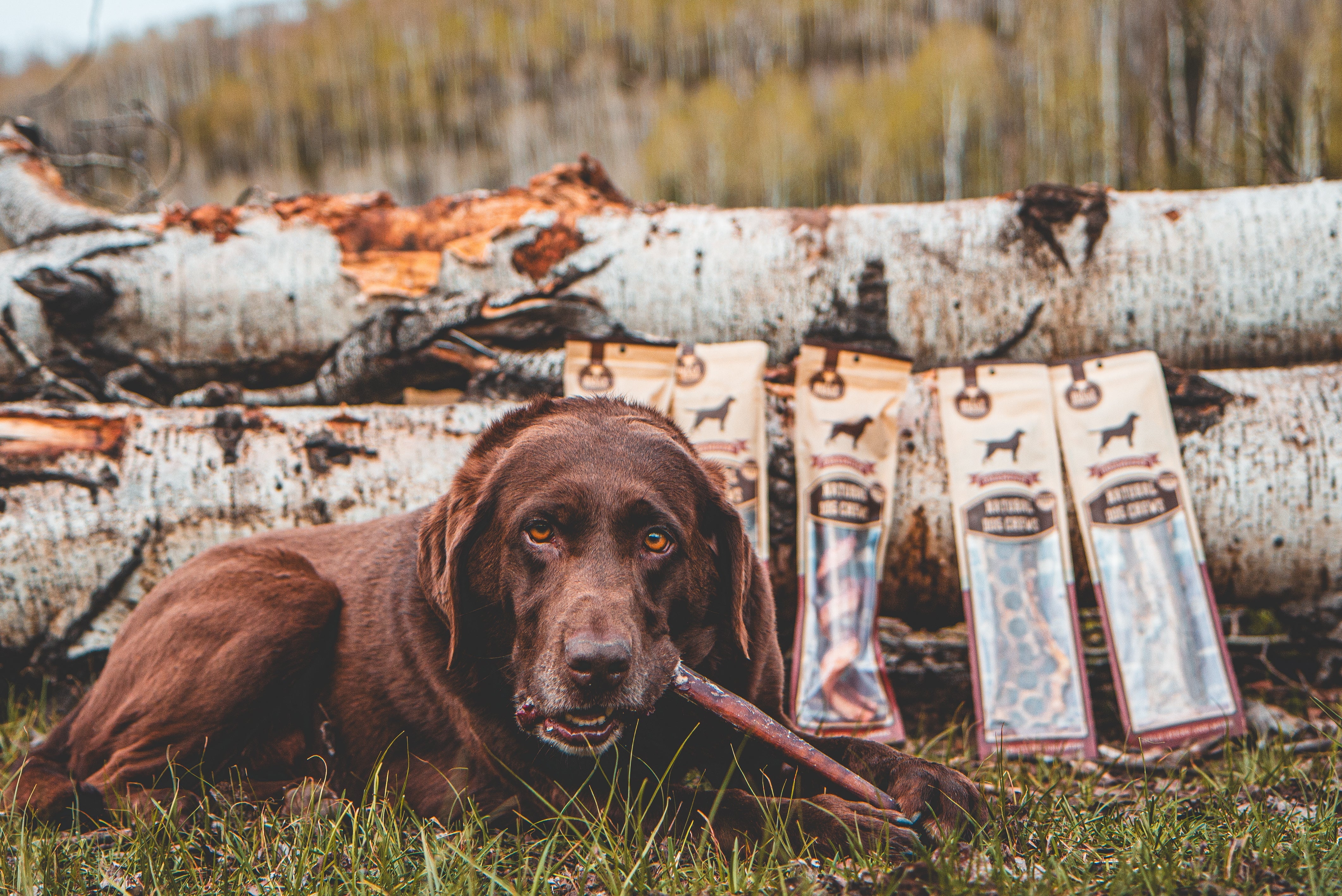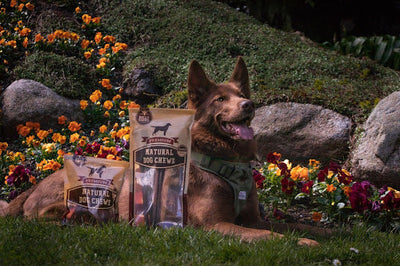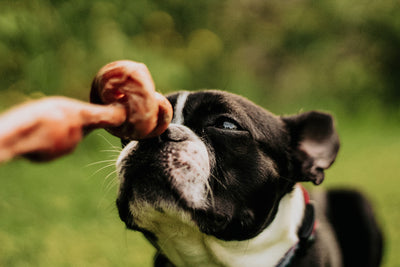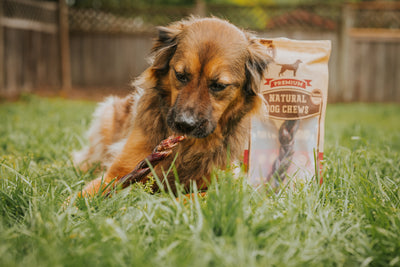What Are Bully Sticks Made Of? Guide to Facts and Benefits
If you’re a dog owner, then congrats! You’re a part of the 74% of the population who love dogs in the United States. By now, you’ve probably bought some dog treats in the store (or somewhere online) for your doggo and seen the excited tail-wagging, the tippy-tapping joy they feel when munching on whatever you give. But before you get ahead of yourself, have you considered what you’re actually feeding your precious pooch?
Most pet owners know and love their dogs, but the average dog owner usually doesn't take a hard look at the treats and food that they’re feeding their furry family members. While the Food and Drug Administration (FDA) does have regulations in place to ensure the safety of pet food, it's still up to the pet owner to educate themselves about what they’re getting.
This is where bully sticks come in, but what is a bully stick? And what are bully sticks made of? To answer that, let’s dive into where these great treats came from, bully stick ingredients, and a few reasons why our furever friends love bully sticks.

Dog Treats: A Brief History
It is generally believed by historians that our furry four-legged canine friends were first domesticated somewhere around 14,000 to 30,000 years ago in Europe or somewhere in Siberia - this part isn’t very important. What’s more important is that dogs have made an impression on us humans, otherwise we wouldn’t have kept them around for so long. The first documented instance of a dog treat is in the 1860s. A butcher living somewhere in Europe noticed that he could maximize profits by making biscuits for dogs by using meat scraps that would otherwise be wasted in the trash… keeping this humble butcher shop origin story in mind, it leads us to the present-day question: what are bully sticks made of?
Bully Stick Ingredients: From Butcher Scraps to Pantry Staples
Modern pups can say “sayonara!” to the 1860s butcher shop scraps. Today, dog treats are held to a higher standard compared to the 1860s and the FDA actually regulates pet food to the same safety standards as regular human food. While having federal food safety standards is great for your family dog, that doesn’t give you a free pass to feed them low-quality slop! After all, would you rather eat gas station roller food or would you prefer a nicer, more nutritious snack?
Enter the tried-and-tested canine favorite: bully sticks. What are bully sticks made of? These treats are actually made from penises of steer, usually an adult bull. This might sound weird (and frankly a little gross for humans), but your doggo will absolutely love it. When discussing bully stick ingredients, there is usually only one: the dried bull penis (also known as the “pizzle”). Bully stick ingredients don’t usually include any artificial flavoring but with the rising popularity of this treat, some manufacturers are adding some creative all-naturale pizazz to the pizzles such as salt, natural wood smoke, and other flavorings.
What Is A Bully Stick? How Pizzles Are Made
We’ve answered “what are bully sticks made of?” but specific steps in the process are what makes bully sticks unique from each other. This doggo-favorite all-natural chew starts at a cattle farm. The cattle are slaughtered and the pizzle is sent to a manufacturer (usually in bulk shipments) to be turned into bully sticks.
After arriving at the bully stick manufacturing facility, the raw pizzles are then cleaned up and given a cursory rinse to keep the product fresh. From there, the bully stick is sometimes braided to create a pattern, wrapped to give it a spiral spring shape, or whatever other shape is desired. The pizzle is then dehydrated at specified temperatures to rid the puppy product of bacteria and other harmful microorganisms.
Roasting the treats also serves to impart some roasted flavors into the bully stick, (similar to how traditional beef jerky is made). The big difference between the bully sticks and beef jerky is that one is, well, a pizzle, and the other is usually made from top or bottom round beef. Beef jerky for humans is smoked and marinated with blends of spices to give it more flavor. Traditionally-made bully sticks get no flavoring additives and are usually just salted by the naturally occurring salt that is found in the pizzle.
Once the treats are dehydrated, the treats are cut to size and packaged for shipping straight into your pupper’s eager mouth! So really, bully stick ingredients are actually made with two things: pizzle and love for your doggo.
Bully Sticks: More Than One Trick
Because bully sticks are an all-natural beef tendon product, there is no risk of splintering and causing any internal problems to your fluffy fido. Veterinarians also praise these wonderful treats as being a great way to keep dogs’ teeth clean. The combination of the tough-but-soft fibers in the dehydrated product massages their gums and keeps their teeth in great shape; just keep in mind that bully sticks are not a replacement for regular oral care of your fluffy friends.
Bully sticks can also last a fairly long time depending on the size of the stick and how big your doggo is. The typical bully stick's lifespan, if you will, is around fifteen minutes to an hour. This means that if you have a young puppy, then you can have fifteen minutes to an hour of non-suspicious silence where you can rest assured they’re happily munching on a bully stick instead of your brand-new couch.
Precautions for Pizzle-Loving Puppers
Why do bully sticks smell? Sometimes our pups eat some truly weird or gross things (like moldy shoes, couch cushions, or your kid’s homework) and you think that surely the fluffy fido can handle a roasted pizzle. While these treats are great for your four-legged family member, there are risks to all good things such as:
Forgetting to Chew:
The most obvious risk is that sometimes your pup gets too excited and forgets to chew their treats. If this happens, bully sticks can become a choking hazard. This risk level can vary depending on the size and temperament of your pup. If your pup is the kind of good boy or girl that likes to inhale their treats instead of chewing them, we highly recommend supervising them while they enjoy bully sticks. Try holding it for your sweet baby for the first few minutes and monitor closely. If you’re looking for an easy set-and-forget solution, get a bully stick holder for dogs! Bully stick holders are a great way to turn a regular treat into an interactive activity to keep your dog engaged and safe while enjoying bully sticks.
Puppies Letting it Get Too Gross:
Most of the time, your dog will chew through a bully stick in less than an hour. But sometimes, your pup might bury it somewhere like a pirate or otherwise forget about it for a few days. While this is an unlikely scenario, the bully stick could start molding or deteriorating (especially if it's left in a moisture-rich environment). If this happens, it's best to toss the stick in the trash if you find it before your furry pirate friend.
Humans Letting it Get Too Gross:
According to Feeding America, about 408 billion dollars worth of food is thrown away every year! The most notable reason is that the food item exceeded expiration dates. Personally, I blame the short attention spans that lead us to forget we have food in the pantry. That being said, bully sticks do have an average expiration date of around 2-3 years after manufacturing. If you’re the type of person to forget about the treats you’ve purchased for your fluffy fido, then consider buying a bully stick holder for dogs! The bully stick holder for dogs also doubles as a dog toy and it’ll be hard for your fido to hide a brightly colored oversized dog treat holder.
How Often Should Dogs Have Bully Sticks?:
We get it, you want to spoil your dogs because you love them, but the truth is that there can be too much of a good thing. The average bully stick contains about 10 to 20 calories per inch. According to Pet WebMD, roughly 10% of your dogs’ daily diet should be composed of treats, and exceeding this amount could lead to canine obesity. While chunky dogs are great for internet memes, plus-sized pups typically have health problems later in their lives such as diabetes, greater risk of cancer, heart disease, and hypertension. So how often should dogs have bully sticks? We recommend treating one per day, since these treats can be calorie-dense.
Perfect Products for Perfect Pups
We all know that dogs are more than just four-legged animals. Our dogs are companions, fluffy family members, and sometimes dutiful service animals. There’s a reason why many dogs learn the word T-R-E-A-T very early in their lives because they know that it's time for delicious dog delicacy!
Next time you attend a puppy party with your perfect pooch and someone asks, “what are bully sticks made of?” you’ll have the full parable to parade to puppy-owning peers about why these pizzle products are so popular on the planet Earth! The best bully sticks and dog treats are at Bully Bunches, treat your lovable little one today!







